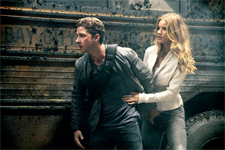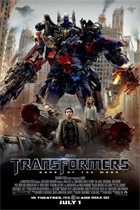Transformers: Dark of the Moon
|  Transformers: Dark of the Moon, Michael Bay’s latest adolescent fantasy for grown men, is a moderate improvement over both of its predecessors, which is about the best thing it has going for it. Those who have seen either of Bay’s previous action juggernauts based on the 1980s-era Hasbro line of plastic toys have pretty much already seen Dark of the Moon, at least in spirit. The first two movies were international mega-hits despite constant critical damnation and no lasting cultural impact in terms of audience adoration (people went to see them because it was the thing to do), so Bay has chosen not to mess with the formula. However, he should get credit for dialing down some of his more attention-addled aesthetic tendencies even though he still leads with a lead foot when it comes to portraying human beings (any imprint from executive producer Steven Spielberg is once again completely missing) and has never quite figured out how to incorporate humor above a fifth-grade level. The movie is still way too long for its own good--clocking in at an astounding 157 minutes--but the pace is much better, making the inevitable repetitiousness of giant sentient robots smashing each other over and over again (this time in 3D!) seem less painful. You feel bruised by the end of the movie, but not completely battered. Transformers: Dark of the Moon, Michael Bay’s latest adolescent fantasy for grown men, is a moderate improvement over both of its predecessors, which is about the best thing it has going for it. Those who have seen either of Bay’s previous action juggernauts based on the 1980s-era Hasbro line of plastic toys have pretty much already seen Dark of the Moon, at least in spirit. The first two movies were international mega-hits despite constant critical damnation and no lasting cultural impact in terms of audience adoration (people went to see them because it was the thing to do), so Bay has chosen not to mess with the formula. However, he should get credit for dialing down some of his more attention-addled aesthetic tendencies even though he still leads with a lead foot when it comes to portraying human beings (any imprint from executive producer Steven Spielberg is once again completely missing) and has never quite figured out how to incorporate humor above a fifth-grade level. The movie is still way too long for its own good--clocking in at an astounding 157 minutes--but the pace is much better, making the inevitable repetitiousness of giant sentient robots smashing each other over and over again (this time in 3D!) seem less painful. You feel bruised by the end of the movie, but not completely battered.The screenplay by Ehren Kruger, who shared script credit on the second film with Alias veterans Roberto Orci and Alex Kurtzman, who also wrote the first one, is a much more intelligible affair that keeps the plot and action more or less coherent. The movie begins in clever fashion with an alternate history lesson in which we learn that the space race of the 1960s was in response to a Transformer spaceship crash-landing on the dark side of the moon. Bay and his team of editors mix actual footage of President Kennedy and the scientists at NASA with their own recreation of the Apollo 11 landing, whose real goal was to explore the crashed ship and retrieve anything they could. We then leap forward to the present day, where we are dragged through a monotonous comedy of errors as returning hero Sam Witwicky (Shia LaBeouf, struggling mightily to make an impression), now a certified college graduate, tries to land his first job in the nation’s capitol, all the while bemoaning his perceived lack of importance after having helped save the world twice. He has little success in the job market, but he still scores in the romance department, replacing Megan Fox with Victoria Secret’s model Rosie Huntington-Whiteley, over whose body Bay’s camera relentlessly drools (she is introduced, not surprisingly, as a disembodied set of naked legs and feet, thus ensuring from the outset that we are not meant to see her as a complete person, but rather as a body to be possessed and fought over). Huntington-Whiteley, who is more or less competent in her first acting role, plays a British diplomatic aid who now works in the office of a smug multi-millionaire played by Patrick Dempsey, thus adding sexual tension to the film’s already overheated dynamics, which also include John Malkovich in a completely random role as Sam’s obsessive-compulsive new boss and Ken Jeong as a bizarro co-worker. The object of battle between the Autobots (the good Transformers) and the Decepticons (the bad Transformers) is a set of pillars that, when put into action together, form a space-time gateway that can only be controlled by Sentinel Prime, the former leader of the Autobots who is brought back to life by Optimus Prime, the current leader and epitome of all that is good and righteous in the universe (one could make a fun drinking game out of Optimus Prime’s constant declarations about “freedom” throughout the film). The Decepticons, who have apparently taken refuge in the Serengeti after their beatings in the previous two movies, have their own plans, and the movie builds to an extended battle in Chicago (the first movie trashed Los Angeles and the second reduced the pyramids of Egypt to rubble) that represents Bay’s best action filmmaking since The Rock (1996) and the attack sequence in Pearl Harbor (2001). The battle sequences actually maintain spatial coherence, largely because Bay eases off the editing button and allows the action to unfold in lengthier shots that allow us to appreciate the composition, scope, and detail of the CGI mayhem, rather than just having our brains rattled. The best sequence takes place in a collapsing office building, with the main characters hanging on as Bay teases us with vertiginous suspense that is sadly lacking in most of his oeuvre. Of course, even when Bay is at the top of his game he can’t help but keep pushing and pushing until it all goes over the top, but at this point we couldn’t (and shouldn’t) expect anything else. At one point, Optimus Prime intones that “In any war, there are calms between the storms,” although he might think twice about that statement if he ever watched one of Bay’s movies. Copyright ©2011 James Kendrick Thoughts? E-mail James Kendrick All images copyright © Paramount Pictures |
Overall Rating: 
 (2)
(2)


